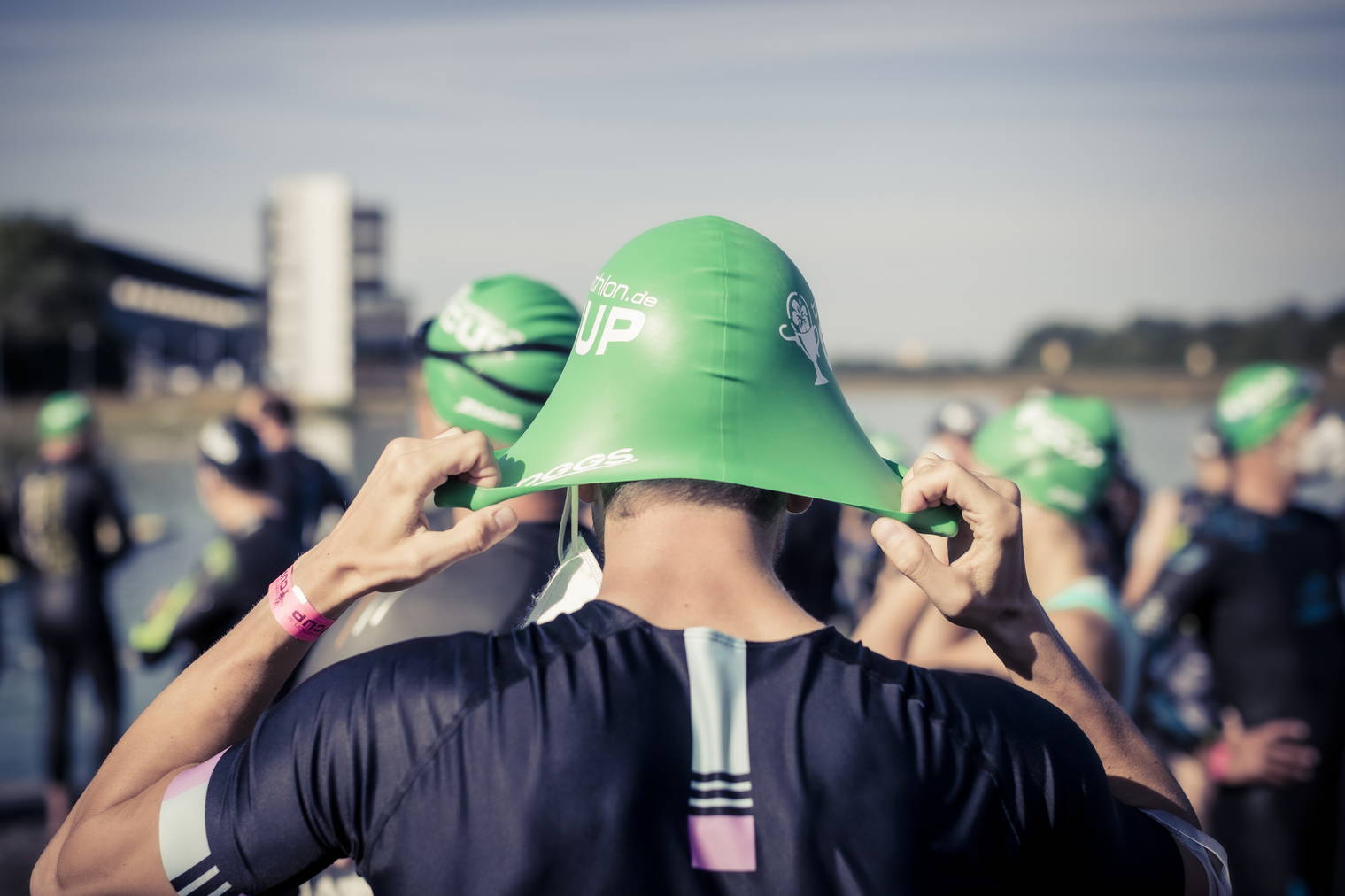Schwimmen - die erste Disziplin. Beim Volkstriathlon kann die Streckenlänge je nach Veranstaltung zwischen 500 - 750 Metern variieren. Im folgenden Beitrag findest du einen Überblick für den Start des Triathlons und vier Schritte, wie du in vergleichsweise kurzer Vorbereitung deine gewünschte Leistung erzielen kannst.
Technik
Beim Schwimmen merkt man schnell, dass eine Verbesserung und Ökonomisierung der Technik zu großen Leistungsfortschritten führt. Springe daher nicht einfach ins nächstbeste Becken und schwimm ziellos deine Bahnen, sondern arbeite von Anfang an daran, dass du dich möglichst effektiv durchs Wasser bewegst.
Nutze deinen Anfängervorteil
Bist du neu beim Triathlon und vor allem beim Schwimmen, besitzt du einen Vorteil, gegenüber manchen erfahrenen Schwimmern. Du kannst nämlich von Anfang an auf eine saubere Technik achten, während manche Schwimmer die erste Triathlon-Trainingszeit darauf richten müssen, für den Dreisport ungeeignete Bewegungen los zu werden. Und das fällt deutlich schwerer als neue Bewegungsmuster zu erlernen, da die schlechte Technik bereits verinnerlicht und Teil der Schwimm-Routine ist. Damit du die, für den Triathlon, richtige Fortbewegung im Wasser leicht erlernst, kommen wir zum nächsten Punkt.
Hol dir Hilfe
Beim Schwimmtraining mit Fokus auf Technik gibt es ein Problem. Es ist nur sehr schwer möglich, die eigenen Bewegungen zu beobachten und zu verbessern. Daher ist es empfehlenswert, die ersten Technik-Einheiten unter Aufsicht eines Schwimmtrainers zu absolvieren, der dich bei falschen Bewegungen sofort korrigieren kann. Falls du lieber alleine trainierst, solltest du überlegen, dein Schwimmtraining zu filmen um dadurch selbst Verbesserungspotenzial zu erkennen. Am besten ist es natürlich, an einem auf Anfänger ausgerichteten Schwimmtraining eines Triathlon- oder Schwimmvereins teilzunehmen.
Übe das Kraulen
Obwohl Freistil erlaubt ist - Brustschwimmen ist für den Triathlon nicht gut geeignet. Aufgrund großer Schwankungen der Vortriebsgeschwindigkeit und der starken Belastung der Beinmuskulatur ist Brustschwimmen für Triathleten eine unökonomische Wahl. In der ersten Disziplin solltest du darauf achten, deine Beine nur wenig zu belasten, da diese noch für Radfahren und Laufen fit bleiben müssen. Die meiste Kraft erfolgt daher aus den Armen, da diese später nur noch Haltearbeit leisten müssen, weswegen sich Kraulschwimmen als effizienteste Technik durchgesetzt hat. Der Beinschlag wird dabei meist soweit reduziert, dass er größtenteils nur noch zum Erhalt der idealen Wasserlage (möglichst flach) durchgeführt wird. Fällt es dir aber schwer die gesamte Strecke zu kraulen, kannst du zur Erholung auf Rückenschwimmen zurückgreifen, da die Atmung dabei leichter fällt. Jedoch ist es deutlich langsamer als Kraulschwimmen und bietet schlechtere Orientierung, weswegen du im Idealfall versuchen solltest diese Pausen so selten und kurz wie möglich zu halten.
In 4 Schritten zum Wettkampf
1. Schritt - Erlerne die Technik
Verbringe die ersten zwei bis vier Wochen, mit je zwei Einheiten pro Woche, damit, dich (im Idealfall mit Trainer) voll und ganz auf deine Technik zu konzentrieren. Diese Zeit sollte reichen um sich zumindest eine gute Grundlage anzueignen und du wirst merken, dass du damit einen deutlichen Vorteil zu unstrukturierten Schwimmern besitzt.
2. Schritt - Festige deine Technik
Wenn du dich beim Schwimmen soweit sicher fühlst und die Grundtechnik gut beherrschst, solltest du versuchen, dass diese automatisiert und korrekt angewendet werden kann. Besitzt du nämlich eine routinierte Grundlage, kannst du dich besser auf einzelne Bewegungsabläufe konzentrieren und dadurch deine Technik noch weiter verfeinern. Darauf solltest du dich dann nach Schritt 1 die nächsten vier bis sechs Wochen konzentrieren.
3. Schritt - Ausdauer aufbauen
Hier ist ein Beispielprogramm für 500 Meter mit je 2 Einheiten pro Woche:
Einschwimmen: 2 x 50 Meter locker in Brust- oder Rückenlage
Technik: 6 x 50 Meter Technikübungen (25m Technik + 25m Kraul)
Geschwindigkeit: 2 x 50 Meter (25m Kraul-Steigerung - locker abstoßen und Tempo bis zur Maximalgeschwindigkeit steigern, danach 25m locker Kraul)
Hauptteil:
1. Woche
Einheit 1: Kraul-Pyramide: 25m - 50m - 75m - 100m - 75m - 50m - 25m mit je 30s Pause
Einheit 2: 10 x 50 Meter Kraul mit 60s Pause
2. Woche
Einheit 1: Kraul-Pyramide: 25m - 50m - 100m - 150m - 100m - 50m - 25m mit je 30s Pause
Einheit 2: 5 x 100 Meter Kraul mit 60s Pause
3. Woche
Einheit 1: Kraul-Pyramide: 50m - 75m - 100m - 150m - 100m - 75m - 50m mit je 30s Pause
Einheit 2: 5 x 50 Meter Kraul mit 30s Pause + 5x 100 Meter Kraul mit 60s Pause
4. Woche
Einheit 1: Kraul-Pyramide: 50m - 100m - 150m - 200m - 150m - 100m - 50m mit je 30s Pause
Einheit 2: 8 x 100 Meter Kraul 60s Pause
Ausschwimmen: 2 x 50 Meter locker Brust und Rückentechnik
4. Schritt - Gib deiner Technik den letzten Schliff
Damit du am besten für den Wettkampf vorbereitet bist, fehlt jetzt nur noch das Gefühl fürs Freiwasser. Dafür eignet sich am besten, Dauerschwimmen in einem See, spätestens ab ungefähr einer Woche vor dem Event. Im Idealfall übst du die Orientierung im offenen Gewässer direkt am Wettkampfort. Schaffst du es dort 15 Minuten zu schwimmen und fühlst dich danach noch fit für die nächsten beiden Disziplinen, bist du gerüstet für deinen ersten Volkstriathlon!
Und denk dran, falls es im Wettkampf doch zu starker Ermüdung kommt, sind ein paar Abschnitte in Rücken- oder Brusttechnik völlig ok!
Die gesamte Serie: Fit für den Volkstriathlon
#1 Schwimmen: in 4 Schritten zur gewünschten Schwimmzeit




















